Annalise Flynn: If you think of the studio as a generative space of experimentation, trials, failures, and discovery—a performative space that is activated by the artist—what happens when you move this process-based work out of the studio space? What does it become when it is recreated here in the Sullivan Galleries versus the original happening of the mural in the studio?
Bobby Gonzales: I think that is the fine balance… That’s the most difficult thing to maintain, wanting to feel like the actions are still fresh and authentic and not a contrived reenactment. That’s why I feel like it’s important to keep the decision making process open. I knew that I was going to paint my wall in the MFA Show in the same way that I did in my studio—and this would be something that would definitely connect the exhibition space with my studio practice. Other than that, I left it completely open. I knew I had made some collages that might make an appearance in the MFA Show installation, but I wasn’t sure which ones and I wasn’t sure exactly in what format. Once I painted the wall in the gallery space, it started to come together. I wanted the decision making to stay alive as I was installing to keep it feeling fresh. That things could change at any moment keeps the energy in the right place.
AF: Was this work at all informed by knowing that it was going to be shown in the MFA Show, or was it purely something that happened in your studio?
BG: I knew it would be adapted to whatever space I received in the MFA Show, but certain things happened in here [the Sullivan Galleries] that definitely related specifically to this spot [in the show]. I had another iteration of a sculpture—a yellow rod that I had taped to the floor—that I had tried to translate from the studio into the gallery space. I started taking some pictures with that rod in the gallery space, and I was thinking I would make a new collage based on that. It didn’t come together in the way that I wanted, but it was okay, I’m glad I tried it at least.
I think that’s something [a direct translation of the work from the studio to the gallery] I hoped maybe would happen, but sometimes it works, sometimes it doesn’t. Sometimes I think I should be more hard-lined, like, “no, this is going to be directly in response to the site,” but really I think that’s sort of silly. Why not allow myself to work in whatever way ends up working best and be completely adaptive? I’m a Pisces, I’m a water sign, and we tend to take the shape of our container. That’s kind of the way I work.
AF: Considering the fluidity of the studio space and how important experimentation and process are to the way you work, do you think a piece can ever actually be finished in the studio? Or do you think it’s only finished once it leaves?
BG: I think it mostly has to be seen whether that’s in the studio or the gallery, I mean there’s a difference, for sure. But, I think it more has to do with being activated by the viewer more so than having to be in a public space verses in my private space.
AF: For you, what changes in the viewership when they are entering into your private space versus when they are coming to a space like the Sullivan Galleries?
BG: I think there’s a feeling of exposing oneself whenever you have an art show no matter what kind of artist you are. You’re in a vulnerable position in a sense. You’re also in a position of power because you also get to make decisions that affect people, affect viewers and have a chance to communicate something. I think the main difference is when you’re in the studio looking at the work, you feel like you’re in someone’s personal, private space. That’s kind of the hard thing to translate between the studio and the gallery. You feel like maybe you’re trespassing if you’re in the studio and I like that. I feel like that’s part of the way it feels when I’m making the work. I feel like I’m doing something I shouldn’t be doing… like I could get caught. And that’s an important psychological mindset that is something that has been in my work for a long time regardless of whether it was work I made in the studio. Even when I’m taking pictures in my studio, the lights are out, and I’m just shooting with a flash, and it feels like I’m somehow trespassing… Playing in the dark.
AF: I think that’s really apparent to the viewer—that you’re seeing someone do something they shouldn’t be doing.
BG: When I’m making, I have two selves. I have the self that I understand to be othered in society, and then I have the self I present to the world, and there’s a disconnect. Working with collage in this way allows me to give the viewer a glimpse through the keyhole into the closet, the gay closet. And this othered, internal self that is freaky and queer and experiences gender fluidity and has kinky, f-ed up thoughts. I want the viewer to feel like they stumbled upon something they shouldn’t have.
AF: A voyeur.
BG: Yes, the voyeur, totally.


